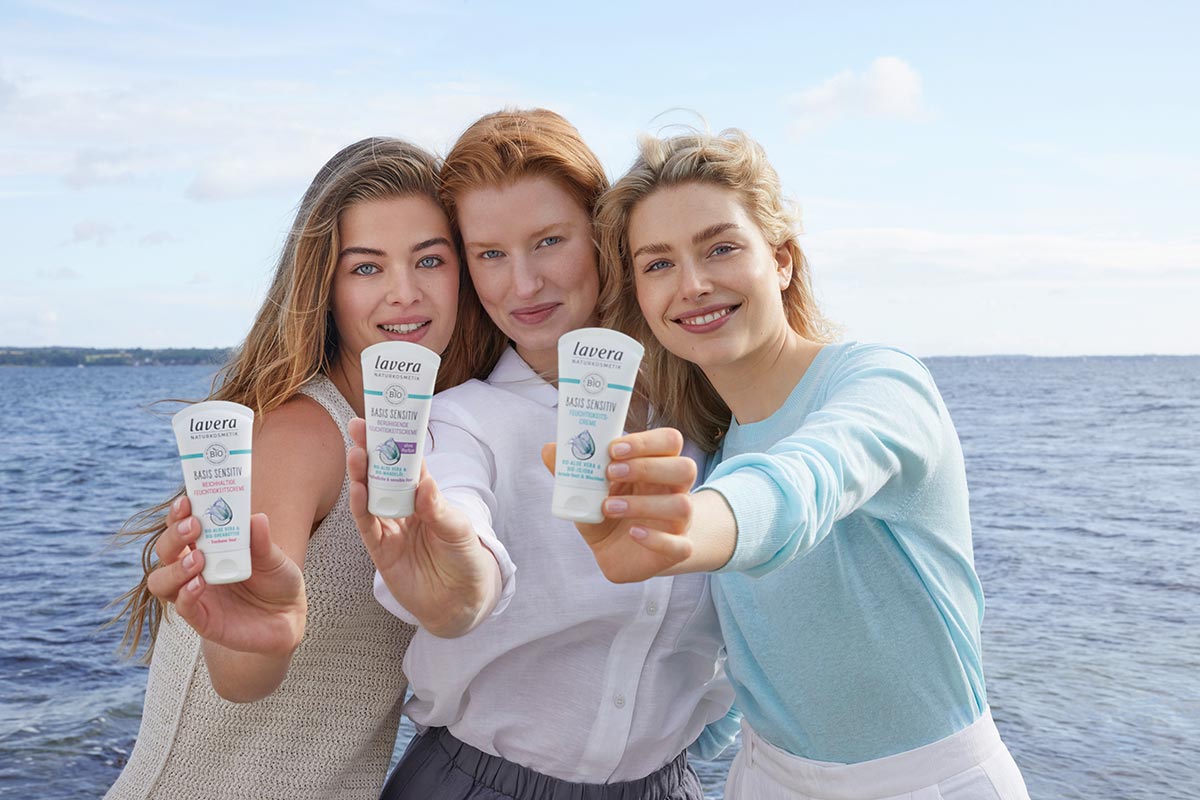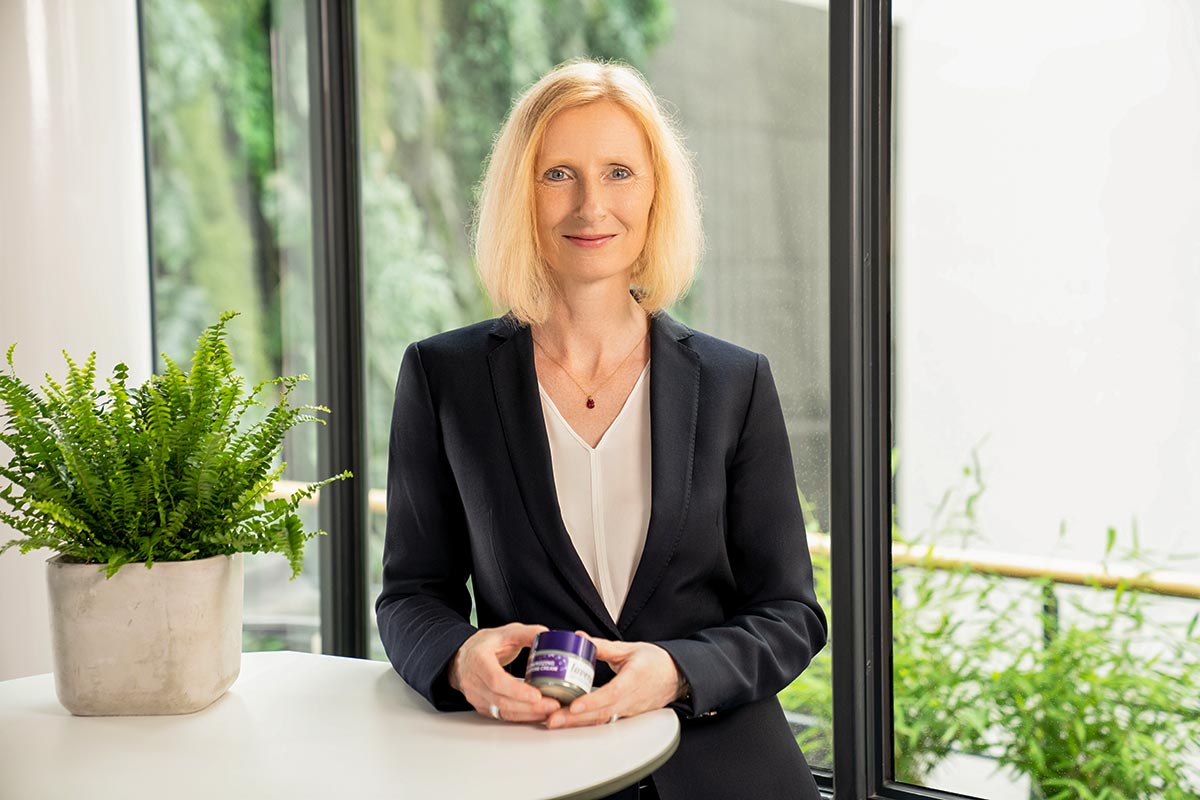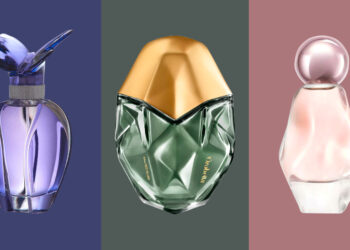Have you ever paid close attention to the small print? With products from lavera Naturkosmetik, we don’t have to worry – after all, everything in the creams, serums, lipsticks and eye shadows comes from nature. Dr. Henrike Neuhoff heads the scientific department at lavera Naturkosmetik and knows why it is worthwhile for skin and nature to use natural cosmetics.
FACES: How are natural cosmetics different from conventional beauty care?
Dr. Henrike Neuhoff: Only natural ingredients or nature-identical ingredients are used in certified natural cosmetics. Environmentally harmful substances such as silicones, kerosenes or solid and liquid microplastics, which are found in conventional cosmetics, are taboo in certified natural cosmetics.
FACES: How can I tell that it’s certified natural cosmetics?
Dr. Henrike Neuhoff: This can be recognized by the NATRUE or COSMOS Ecocert seals. The NATRUE Association was founded in 2007 by lavera and other natural cosmetics manufacturers. These seals were created to set binding standards for certified natural cosmetics, to guarantee consumers tested quality on the cosmetics shelf and to distinguish “greenwashing” from genuine natural cosmetics.
Certified natural cosmetics
FACES: lavera Naturkosmetik relies exclusively on certified natural cosmetics. Why is this so important for the skin?
Dr. Henrike Neuhoff: Synthetic cosmetics often contain artificial fragrances and preservatives. In certified natural cosmetics, on the other hand, only natural ingredients are used, following nature’s example. Numerous natural oils, fats and waxes are used, as well as natural proteins, amino acids, minerals, vitamins and plant extracts or powerful active ingredients such as fermented hyaluronic acids, Q10 and much more. Depending on the plant, there are various skin-promoting properties such as moisturizing, anti-inflammatory, sebum-regulating, astringent, soothing, antioxidant, etc. This means that these natural ingredients not only provide lasting care for the skin, but also positively support the skin and supply it with valuable substances that it may lack for an intact skin layer and cell membrane. This allows the skin to regenerate naturally.
FACES: Why is natural cosmetics also good for the environment?
Dr. Henrike Neuhoff: Silicones and other synthetically produced substances used in conventional cosmetics, for example, get into the groundwater via shampoos, conditioners and soaps, but also through face creams, make-up removal products and the like, and pollute the environment. They are deposited in the rivers and end up in the sea. To protect the skin and our environment, lavera uses biodegradable* formulas of 100 percent natural origin, 100 percent natural fragrances and produces over 300 extracts in organic quality itself. These can easily be returned to the biological cycle – because what is made from nature can also be processed by nature.
FACES: And what about the packaging of natural cosmetic items?
Dr. Henrike Neuhoff: Recycling is a big issue in natural cosmetics. On the one hand, this is about conserving natural resources, but on the other hand it is also about reducing CO2 emissions. For example, lavera consistently uses reusable materials such as recyclates for its product packaging. These are materials obtained from old water, juice and milk packaging. The bottles of our lavera body lotions, shampoos, conditioners and showers are already made from 100 percent recycled material. We can see the effect of this change alone in the following example: In 2022 alone, we saved a total of 16 tons of CO2 just by converting the packaging of our body lotions to 100% recycled content – this corresponds to around 17,200 washing cycles of a washing machine at 60 degrees.

Everything about ingredients
FACES: Where do the ingredients for lavera Naturkosmetik’s beauty products come from?
Dr. Henrike Neuhoff: Many ingredients are obtained from controlled organic cultivation. Here, care is taken to ensure that the produce is grown without the use of chemical fertilizers or synthetic pesticides. The lavera product world has carried the organic logo for over ten years and stands for our more than 300 organic plant ingredients, plant fluids and organic plant complexes, most of which we produce ourselves in the Hanover region.
FACES: Which new ingredients are high on the agenda right now and why?
Dr. Henrike Neuhoff: Natural active ingredients such as fermented hyaluronic acids, natural Q10, the natural and gentle retinol alternative bakuchiol, ceramides, peptides etc. are “all-time favourites” due to their outstanding anti-ageing effect – because the issue of natural skin ageing is very important to all consumers. In combination with innovative active ingredients such as vitamin C, for example, we have launched an innovative product line on the market in our “Glow by Nature” series, which reduces signs of tired skin and provides a natural energy boost.
Bakuhiol as a natural alternative to retinol
FACES: Bakuchiol is the natural alternative to retinol. Are such natural ingredients just as effective as their chemical counterparts?
Dr. Henrike Neuhoff: Yes, because although the chemical structures are different, the mode of action of bakuchiol is comparable to that of retinol. Like retinol, bakuchiol also has a number of anti-ageing qualities: it has been proven to stimulate the skin’s own collagen synthesis, significantly reduce the depth of wrinkles and improve the skin’s appearance. Another plus: Bakuchiol has the additional advantage over synthetic retinol that it is very well tolerated by the skin and has no photosensitizing properties. It is therefore also suitable for sensitive skin and can also be used during the day.
FACES: What natural fragrances do you rely on for lavera natural cosmetics?
Dr. Henrike Neuhoff: The fragrances consist of natural essential oils, i.e. natural fragrances as they actually occur in nature. Depending on the product, this can be a delicate floral fragrance, a green herbaceous scent or a fresh aquatic or pleasant gourmand note. It is important that they are purely natural. Synthetic fragrances also contain artificial fragrances that are not of natural origin.
The advantages and disadvantages of natural cosmetics
FACES: What circumstances or disadvantages of organic ingredients make your job more difficult?
Dr. Henrike Neuhoff: Unfortunately, natural “organic ingredients” are always relatively expensive and are also subject to seasonal fluctuations. Depending on the harvest, they can vary in color, e.g. contain more or less carotenoids, which is of course reflected in the product color. In general, natural ingredients only have advantages for consumers, as they are well tolerated and biodegradable. However, you also have to be very familiar with the development process, because we deliberately avoid synthetic ingredients such as silicones.
FACES: What preconceptions about natural cosmetics are just plain wrong?
Dr. Henrike Neuhoff: The myth that natural cosmetics don’t feel or smell as good as conventional cosmetics or are not as effective is a thing of the past. Nowadays, natural cosmetics can easily keep up with synthetic cosmetics and are even more sustainable. Power ingredients such as natural Q10, ceramides, natural hyaluronic acids and plant-based bakuchiol work just as well and are even better tolerated in some cases. In general, natural cosmetics provide the skin with natural and lasting care and positive support. It receives valuable natural, partly endogenous substances that it may lack for an intact skin layer and cell membrane. On the subject of fragrance: while conventional products can fall back on around 5,000 synthetic fragrances, natural cosmetics now have approx. 400 fragrances are available – based on natural essential oils. Incidentally, Lavera is known among consumers for its particularly fragrant fragrance compositions. An in-house research and development team not only works continuously on innovative products on a purely natural basis, but also takes care of the perfect fragrance composition. Natural cosmetics also have a lot to offer in the decorative area. Natural make-up covers well, nourishes with natural ingredients and lasts reliably. Given the fact that a woman unconsciously eats an average of 3.5 kg of lipstick in her lifetime, we should think about what we wear on our lips, skin and eyes throughout the day. Nature in particular is full of beautiful, bright and natural colors. Our radiant colors come from natural minerals, plants, fruit and vegetables such as radishes and radishes. The colors are well dispersed or dissolved – and depending on the composition, the tones are close to natural, more intense or even brighter and last wonderfully throughout the day. Our customers confirm this time and time again. And the best thing is that the products can be easily removed in the evening!
*Biodegradable gel or cream formulation according to OECD list with the exception of decorative cosmetics
Dr. Henrike Neuhoff
Since 2015, Dr. Henrike Neuhoff has been responsible for the scientific department in which all lavera Naturkosmetik products are created. His company, Laverana, was founded in 1987 by Thomas Haase. lavera was one of the first to rely on the power of nature and uses purely natural ingredients, some of which it produces itself, to ensure well-groomed, rejuvenated and healthy skin.

You can find out more about lavera natural cosmetics here.
Do you want to make the world a better place? How about shopping in packaging-free stores from now on? Our list of the best stores will help.
Tea photo & photos: © lavera Naturkosmetik








